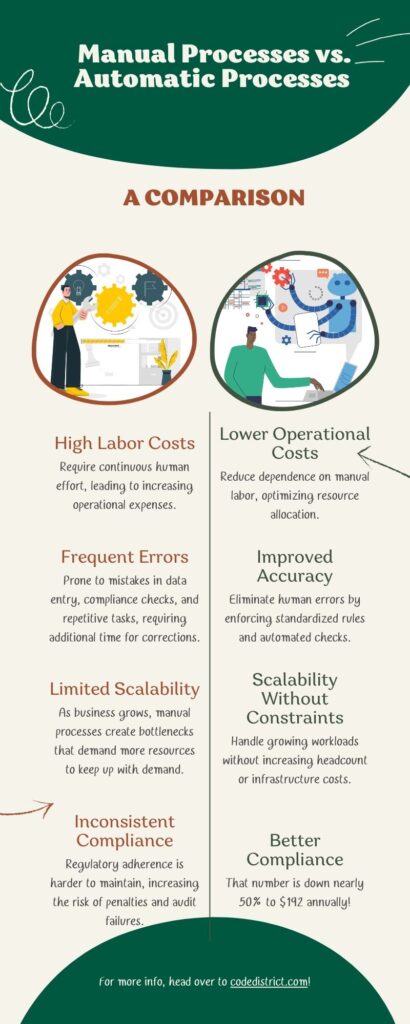How Automation Frees Your Team to Focus on What Matters Most

In the pursuit of growth and efficiency, businesses often find themselves entangled in a web of repetitive, manual tasks that consume valuable time and resources. A recent report highlights that some companies are losing up to $1.3 million annually due to inefficient processes. From processing invoices and managing compliance approvals to handling routine customer service inquiries, these operational inefficiencies add little strategic value yet demand significant effort. Over time, they create a quiet but persistent drain on productivity, limiting an organization’s ability to scale and innovate.
The impact of these inefficiencies extends beyond just lost time. Opportunities are overlooked, decision-making slows, and employees become disengaged as they spend their energy on tasks that could be streamlined or eliminated altogether. As businesses navigate an increasingly digital economy, reliance on manual workflows becomes a growing liability, making it harder to remain agile and competitive. Automation has moved beyond being a technological advantage to becoming a business necessity. The real challenge is no longer deciding whether to automate, but determining which processes will deliver the greatest impact when optimized.
Manual Processes vs. Automated Workflows: A Comparison
Manual processes may seem manageable at first, but as businesses grow, they become a major bottleneck. Here’s a breakdown of how manual processes compare to automated workflows and why automation is the smarter, more efficient choice for businesses:

Where Time Gets Wasted
Every business, no matter its size or industry, has processes that keep operations running but add little strategic value. These tasks, often repetitive and manual, consume a disproportionate amount of time, slowing down productivity and limiting the ability to focus on higher-impact initiatives. While they may seem routine, their cumulative effect creates bottlenecks that affect efficiency, accuracy, and overall business agility.
Manual data entry is one of the most persistent culprits. Whether transferring information between systems, updating records, or consolidating reports, employees spend valuable hours on tasks that could be automated. Beyond the inefficiency, the potential for human error increases, leading to costly corrections and delays.
Invoice processing is another significant drain on time. From generating invoices to tracking payments and reconciling accounts, finance teams often find themselves caught in cycles of paperwork, approvals, and follow-ups that slow cash flow and create unnecessary administrative burdens.
Customer service teams face a similar challenge. Handling repetitive inquiries—such as answering common questions, processing basic requests, or resolving straightforward issues—pulls focus away from more complex, value-driven customer interactions. Without automation, teams must repeatedly respond to the same inquiries instead of directing their efforts toward customer retention and relationship building.
Compliance and approval workflows also contribute to operational slowdowns. Whether it’s internal approvals for budgets and expenses or external regulatory compliance checks, reliance on manual processes can lead to unnecessary delays. With multiple layers of oversight, waiting for approvals can stall projects, incur penalties, disrupt timelines, and create friction across teams.
These inefficiencies compound over time, leading to wasted resources, frustrated employees, and missed opportunities for business growth. The key to overcoming these challenges lies in identifying which workflows can be streamlined, allowing businesses to operate with greater speed, accuracy, and strategic intent.
How Automation Redefines Workflows
Faster Operations Without Bottlenecks
Manual tasks drain time and limit growth. Automation streamlines workflows, reduces costs, and drives business efficiency. See how businesses are using automation to boost productivity and scale smarter. Manual tasks drain time and limit growth. Automation streamlines workflows, reduces costs, and drives business efficiency. See how businesses are using automation to boost productivity and scale smarter.
Minimizing Errors for Greater Accuracy
Human errors in manual processes—such as miskeyed data, misplaced documents, or overlooked compliance requirements—can lead to costly consequences. Automated workflows follow predefined rules with precision, maintaining consistency and detecting potential issues before they escalate. This is particularly valuable in industries where compliance, financial reporting, and data integrity are critical, reducing the risk of regulatory penalties and operational mishaps.
Reducing Costs and Maximizing Efficiency
Automation directly impacts a company’s bottom line by reducing labor costs, eliminating inefficiencies, and minimizing waste. Businesses no longer need to allocate valuable human resources to repetitive administrative tasks, allowing employees to focus on higher-value initiatives. Additionally, fewer errors mean lower rework costs, and streamlined workflows translate into higher productivity without increasing operational expenses.
Boosting Employee Engagement and Job Satisfaction
Repetitive, low-value tasks can be frustrating and demotivating for employees. By automating routine processes, businesses empower their teams to focus on work that requires creativity, problem-solving, and strategic thinking. This shift not only enhances job satisfaction but also improves overall productivity, as employees spend their time on impactful initiatives rather than tedious administrative duties.
Scaling Effortlessly with Business Growth
As companies expand, manual processes often become bottlenecks that slow down operations and require additional hires to keep up with demand. Automation provides a scalable solution, ensuring that increasing workloads do not compromise efficiency. Whether managing higher transaction volumes, processing large-scale data, or integrating workflows across multiple departments, automation enables businesses to scale seamlessly without sacrificing accuracy or speed.
Types of Automation That Drive Results
Workflow Automation
One of the biggest obstacles to efficiency is the reliance on manual workflows for approvals, reporting, and data processing. These processes often involve multiple handoffs, leading to delays, errors, and unnecessary administrative overhead. Through custom workflow automation, we help businesses remove these bottlenecks, ensuring that tasks move seamlessly through predefined logic without constant manual intervention.
For Source2, a talent acquisition company, we built an automated workflow that streamlined their hiring and onboarding processes. By integrating automation into candidate tracking, approvals, and reporting, they significantly increased application processing times by 84%, improved data accuracy, and enabled recruiters to focus on strategic hiring rather than repetitive administrative tasks. The result? Faster hiring cycles and increased recruiter productivity by 75%. Read the detailed case study here.
For Caribbean Airlines, we replaced multiple spreadsheets with a centralized automated system to unify their ticketing, scheduling, and customer service processes. This allowed real-time data sharing across departments, improving coordination and reducing response times. As a result, claims processing increased by 75%, while passenger experience and operational efficiency saw significant improvements.
AI-Powered Automation
AI-powered automation takes efficiency to the next level by not just executing tasks, but optimizing them through machine learning and predictive analytics. Businesses that deal with complex data sets, decision-heavy processes, or require real-time adaptability see immediate benefits from AI-driven automation.
For Pharmasift, navigating FDA regulations for pharmaceutical advertising was a slow and resource-intensive process. We developed an AI-powered system that predicts potential FDA objections and offers actionable guidelines to address them, reducing the need for manual revisions. This solution improved approval rates by 35%, lowered operational costs by 20%, and increased team productivity by 45%. By automating compliance checks, Pharmasift now enables pharmaceutical companies to get their materials approved faster while ensuring regulatory adherence.
System Integrations
Many organizations struggle with disconnected systems that don’t communicate with one another, forcing employees to manually transfer data between platforms—creating inefficiencies and increasing the risk of errors. System integrations solve this by enabling seamless data flow between software, improving accuracy and saving time.
For Good Clean Love, managing multiple disconnected systems led to repetitive work and inefficiencies. We integrated their platforms using API connectors like Zapier, ensuring real-time data synchronization across all systems. By automating their ERP and e-commerce integration, we eliminated manual order entry, streamlined inventory management, and reduced fulfillment errors—allowing them to scale efficiently without added labor costs.
Custom Automation Solutions: Tailored to Industry-Specific Challenges
Not all automation needs are the same, which is why custom-built solutions deliver the highest ROI for businesses with unique operational challenges. By designing automation around industry-specific pain points, businesses can optimize processes that off-the-shelf solutions fail to address.
For One Digital, a leading provider of insurance, financial services, and HR consulting, managing leave records and payroll processing for their clients required significant manual effort. We developed an automated solution that gathers multiple data files from their clients, compiles them into a single E-file, and generates a CSV output for easy access and interpretation. This automation eliminates manual data handling, streamlines payroll processing, and ensures greater accuracy, enabling OneDigital to deliver more efficient HR services to their clients.
Unlocking Growth Through Smart Automation
When repetitive tasks are eliminated, workflows are optimized, and systems work seamlessly together, your team is no longer burdened by operational inefficiencies. Instead, they’re free to focus on strategic initiatives, innovation, and growth—the work that truly moves the needle.
At Code District, we build intelligent, custom solutions that align with your business goals, ensuring that automation isn’t just a technical upgrade but a strategic advantage. From AI-powered analytics to seamless system integrations, we’ve helped businesses like Source2, Pharmasift, Caribbean Airlines, Good Clean Love, and One Digital transform their operations—driving efficiency, reducing costs, and scaling without limits.
The real question is: How much more could your business achieve if manual work wasn’t holding it back?
Time is money, and every manual task slowing you down is costing you opportunities. So, if you’re ready to streamline your operations, empower your team, and maximize ROI, let’s talk.


